Following a bioinformatic search for new Uap56-interacting proteins, Prof. Stuart Wilson identified around 2007 a new mRNA export adaptor, Uif/Fyttd1, functionally redundant with Alyref 13. Additionally, this search led to the identification of another protein, Luzp4, a known Cancer/Testis Antigen (CTA) also called CT-8 or HOM-TES-85 28.
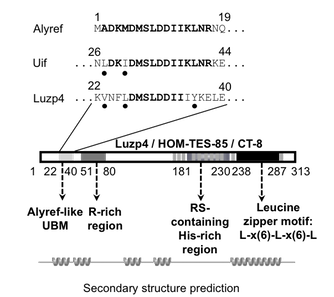
The cancer testis antigen Luzp4 contains a Uap56 Binding Motif (UBM). Here is my proposed organisation of the Luzp4 protein. The consensual sequence of Alyref's UBM and identical residues in Uif and Luzp4 are highlighted in bold. Black dots indicate biochemically conserved residues. The light grey vectical bars are arginine(R)-serine(S) dipeptides.
CTAs are encoded by genes that are normally expressed in human germ cells and trophoblast but are also aberrantly expressed in various cancers. Their restricted expression pattern in normal tissues and their ability to elicit immune response in cancer patients make them promising targets for customized immunotherapies. However, ~ 70 % of the CTAs known to date have no clearly defined function 29.
I was hired in 2008 by Prof. S.A. Wilson to perform an exhaustive functional analysis of the cancer testis antigen Luzp4, which appeared to have a UBM, and therefore could be involved in the [THO-TREX]-dependent mRNA export pathway. When I started this study, the only data available that could give some insight into its function was the fact that it co-localises within the nucleus with areas of transcriptional activity and splicing. This suggested that Luzp4 may be involved in these processes in vivo 28.
During the last few years, I have used a wide range of experimental approaches to characterize this cancer testis antigen. I could show that Luzp4 is an RNA-binding protein that integrates into the THO-TREX complex and interacts directly with the RNA helicase Uap56 and the mRNA export receptor Nxf1 30. Therefore, at least one function of Luzp4 is to promote mRNA export in human cells, as an adaptor for Nxf1:p15.
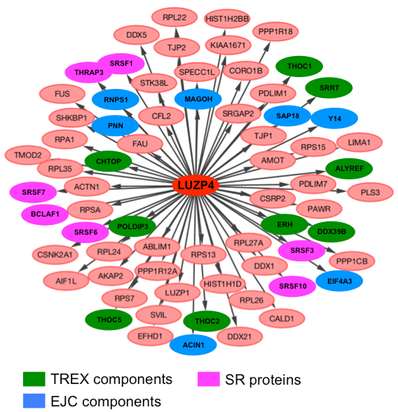
The cancer testis antigen Luzp4 associates with proteins from various stages of gene expression in vivo. I have used a stable inducible Flp-InTM-T-RExTM 293 cell line expressing FLAG-Luzp4 to co-immunoprecipitate protein partners of Luzp4 in vivo and identify them by mass spectrometry. This diagram displays the specific proteins associated with Luzp4 in this experiment.
Using a complementation system for human cells, I could show that Luzp4 functionally complements an RNAi-mediated depletion of the canonical mRNA export adaptor Alyref by rescuing the global mRNA export pathway and restoring cellular growth. Note that this complementation also required the other canonical mRNA export adaptor Uif. This suggests that Luzp4 works in the Nxf1-dependent mRNA export pathway in conjunction with Uif, like Alyref does 13.
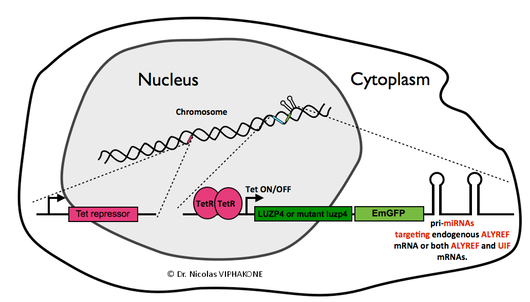
Complementation system used in this Luzp4 study. I have modified the Invitrogen block-iT system in order to express LUZP4 cDNA fused to EmGFP, while targeting the endogenous mRNA of the ALYREF gene alone or also the mRNA of the UIF gene. Using this modified system in combination with the Flp-In-293 cell line (which doesn’t express LUZP4), LUZP4 was capable of rescuing almost completely various phenotypes triggered by the knockdown of ALYREF and partially those triggered by a combined knockdown of ALYREF and UIF.
Interestingly, I observed that LUZP4 was specifically required for the growth of a melanoma cancer cell line.
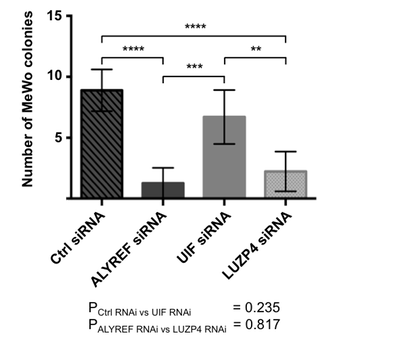
Colony formation assay on a melanoma cell line. Colonies that were scored contained >50 cells. The values shown for all graphs represent the average of five independent experiments, each containing six replicates per condition and the error bars represent the standard deviation.
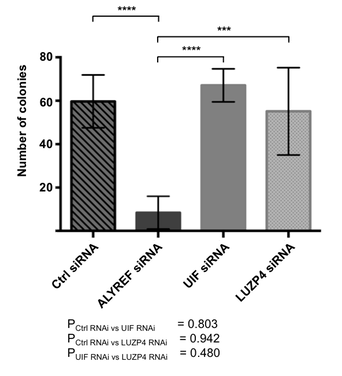
Colony formation assay on 293T cells that don’t express LUZP4. The values shown for all graphs represent the average of five independent experiments, each containing six replicates per condition and the error bars represent the standard deviation.
It is becoming more and more evident that several components of the THO-TREX complex are functionally linked to tumor formation and cancer progression 31,32,33. Cancer testis antigens constitute a promising group of prognostic biomarkers and also possible targets to develop tumor-specific immunotherapies 34,35,36,37. My new study presented here connects this two important topics by showing that the cancer testis antigen Luzp4 can be integrated within the THO-TREX complex in vivo, and is specifically required for the growth a of melanoma cell line.
Interesting and unusual features of Luzp4 (some are in the supplementary data of the study).
- Luzp4 binds RNA via two regions: an N-terminal arginine-rich sequence and a C-terminal leucine zipper domain (maybe thanks to arginines exposed at the surface of that motif).
- Luzp4’s NLS (Nuclear Localisation Signal) is located within its RS-His-rich region (amino acids 178-236).
- during cell division, Luzp4 is relocalised to the cytoplasm and this phenomenon requires its C-terminal leucine zipper domain.
- Luzp4’s intra-nuclear distribution is determined by both its N-terminal residues (residues 22-40 or 1-113) and its C-terminal leucine zipper.
These last two features seem to rely on regions of the protein also involved in binding RNA and/or mRNA export factors.
References used:
Preceding references: 1-5, 6-16, 17-27.
28. Türeci, O. et al. A novel tumour associated leucine zipper protein targeting to sites of gene transcription and splicing. Oncogene 21, 3879–3888 (2002).
29. Simpson, A. J. G., Caballero, O. L., Jungbluth, A., Chen, Y.-T. & Old, L. J. Cancer/testis antigens, gametogenesis and cancer. Nat Rev Cancer 5, 615–625 (2005).
30. Viphakone, N. et al. Luzp4 defines a new mRNA export pathway in cancer cells. Nucleic Acids Res. Feb 27;43(4):2353-66. doi: 10.1093/nar/gkv070 (2015).
31. Domínguez-Sánchez, M. S., Sáez, C., Japón, M. A., Aguilera, A. & Luna, R. Differential expression of THOC1 and ALY mRNP biogenesis/export factors in human cancers. BMC Cancer 11, 77 (2011).
32. Griaud, F. et al. A pathway from leukaemogenic oncogenes and stem cell chemokines to RNA processing via THOC5. Leukemia. doi:10.1038/leu.2012.283 (2012).
33. Guo, S., Liu, M. & Godwin, A. K. Transcriptional Regulation of hTREX84 in Human Cancer Cells. PLoS ONE 7, e43610 (2012).
33. Saito, Y. et al. ALY as a potential contributor to metastasis in human oral squamous cell carcinoma. J Cancer Res Clin Oncol 139, 585–594 (2013).
34. Neumann, F. et al. EBV-transformed lymphoblastoid cell lines as vaccines against cancer testis antigen-positive tumors. Cancer Immunol. Immunother. 62, 1211–1222 (2013).
35. Mirandola, L. et al. Cancer testis antigens: novel biomarkers and targetable proteins for ovarian cancer. Int. Rev. Immunol. 30, 127–137 (2011).
36. Chen, Y.-T. et al. Multiple Cancer/Testis Antigens Are Preferentially Expressed in Hormone-Receptor Negative and High-Grade Breast Cancers. PLoS ONE 6, e17876 (2011).
37. Caballero, O. L. & Chen, Y.-T. Cancer/testis (CT) antigens: potential targets for immunotherapy. Cancer Sci. 100, 2014–2021 (2009).
